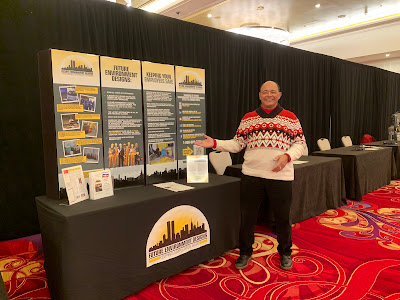Every year we look forward to the
Professional Abatement Contractors of New York's (PACNY's) Environmental Conference. This year was no exception considering it was the 24th annual. The conference started on Wednesday, February 26, 2020, with Proficiency Day and Mr. Angelo Garcia, III of
Future Environment Designs, Inc., (FEDTC) who had the honor this year of starting off the conference. Proficiency Day this year focused on asbestos contamination assessment that was suggested by Mr. James Meacham, PE, of
New York State Department of Labor (NYSDOL) and we greatly appreciated his agreeing to also do a presentation on the topic. In addition, we were able to convince Mr. Bart Gallagher, of
Enviroscience Consultants, Inc., to do a case study presentation on the contamination assessment involved with the Long Island dumping cases. For the second year in a row, proficiency day provided 3 PDH for professional engineers, architects, & other certifications.
 |
| Poll Everywhere Result |
Angelo Garcia, III's presentation focused on the regulatory requirements or the lack of regulatory requirements of asbestos contamination assessments. The presentation also included polling of the audience using
Poll Everywhere. The basic points of the presentation were that most of the information we use regarding contamination assessments come from the
Guidance Document which was a frequently asked questions document created by NYSDOL as a supplement to
NYSDOL Industrial Code Rule 56 - Asbestos Regulation and the collection of dust and debris samples is very tricky, and the most important thing is how do you interpret the results?
 |
| Mr. James Meacham, P.E. discussing Contamination Assessments |
James Meacham's presentation focused on some of the issues NYSDOL has been seeing regarding contamination assessments. He discussed the assessment tools such as using your eyes, documentation, bulk sampling, air sampling, wipe sampling, micro-vacuum sampling, and tape lifts. What do the results mean using these assessment tools and does it need to be zero? Well maybe not. Clean air under state law is less than 0.01 fibers per cubic centimeters of air (that's not zero). Mr. Meacham also discussed debris pile assessment and the need for the inspector to visually inspect the debris for suspect asbestos-containing materials (ACM) and determine if representative sampling is feasible and can be done safely. The presentation included a draft decision tree for debris assessment.
 |
| Bart Gallagher discussing the Case Study |
After a short break, Bart Gallagher's presentation was on the contamination assessment that was done for the Long Island dumping case. Mr. Gallagher's presentation went into the different causes of damage such as environmental causes or ignorance, carelessness, and neglect. Criminal actions are rare...but are committed. The specific points of the Long Island dumping case were that soil borings were done with Geoprobe and split-spoon sampling to test for volatile organic compounds (VOCs), semi-VOCs, metals, polychlorinated biphenyls (PCBs) and pesticides. Test trenches were more effective for finding ACM than the Geoprobe. The variance application to NYSDOL was similar to 56-11.5 controlled demolition with machine excavation and loading into lined trucks/roll-offs, decontamination area for equipment, proper disposal, and project monitoring and air sampling.
 |
| "Remember I'm not in the book" |
The first day then continued later that evening with the PACNY President's (Timothy Thomas, of
Tetra Tech) reception which included drinks and appetizers and a lot of networking. Some of the above presentations are available in our
dropbox folder under conference presentations (2020PACNY presentations) or you can also find them at
PACNY's website. The first day went extremely well and did a great job warming everyone up for the conference yet to come!













